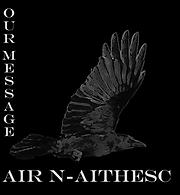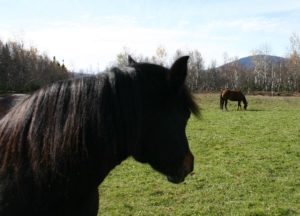Category: wolves
Save a Celtic hound
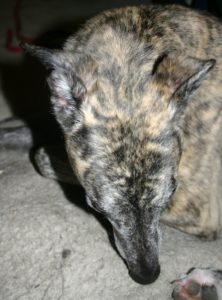 **UPDATE: I realized I should update that we were unable to save our Gráinne. The lymphoma was just too aggressive, she went down hill very quickly and had some sort of episode involving either a lesion or a blood-clot to the brain. She regained her ability to walk after the first one, but the vet was clear that nothing could be done. We planned to take her for her last trip a few days later, but she had another similar episode and we took her to an emergency vet in the middle of the night. We probably do not have to mention that we are devastated as is Gleann. **
**UPDATE: I realized I should update that we were unable to save our Gráinne. The lymphoma was just too aggressive, she went down hill very quickly and had some sort of episode involving either a lesion or a blood-clot to the brain. She regained her ability to walk after the first one, but the vet was clear that nothing could be done. We planned to take her for her last trip a few days later, but she had another similar episode and we took her to an emergency vet in the middle of the night. We probably do not have to mention that we are devastated as is Gleann. **
It been a hell of a year. We lost Sachairi just over a year ago, then found out both Gleann and Gráinne had serious health problems. Gráinne was diagnosed with chronic lymphocytic leukemia (CLL) but her blood count numbers were real low, so during the summer it was a matter of just keeping track while we concentrated on saving Gleann who had a tumor in his parathyroid. We were able to get surgery for Gleann thanks to fund raising, auctioning off some Sarah Connor related stuff, some eBay auctions, help from a dear friend and totally maxing out CareCredit. And then Gráinne’s numbers got higher, not OMG start chemo NOW higher, but high enough we were starting to get her evaluated the first of this year.
And then two things happened. First she developed skin lesions, upping our worry even with the current blood counts. And then my husband Aaron broke his leg. Oh, on top of that at New Years just 12 days before his accident, he had also had his status changed at work from covering stations to only being on-call for transfers, so no disability benefits at all. This leaves us with no real income at all, except for a bit here and there from eBay sales.
Just days before we finally got her to the oncologist for another examination and for more testing, her nose became hugely swollen. It turns out that as well as the CLL she has cutaneous lymphoma, which is the more aggressive of the two.

This means that the chemotherapy we were looking at, Prednisone and Leukeran, is not going to be effective. Instead we need a more expensive chemo, CCNU. She would get this every three weeks at $695 each time and require blood work at her regular vet in the weeks in between. AND this needs to start immediately, before the very quick changing lymphoma has a chance to get to the point of no return!
We could see managing if Aaron were working and getting a lot of shifts….but not until then. Which is April! And we have to stat this week! We have raised not quite as much as we have spent in getting her tested and we are struggling to also feed her and the other animals, so we have almost nothing left to our names at all, let alone enough to start this! We really need help!
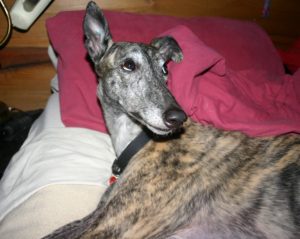 She could have years more with this, it is devastating that we may have to lose her just because Aaron broke his leg!
She could have years more with this, it is devastating that we may have to lose her just because Aaron broke his leg!
Gráinne is our sixth Greyhound, adopted from Greyhound Placement Services, NH as a special needs dog due to having epilepsy. She is beautiful, as you can see, but also quirky and comical. She is not always the easiest hound to deal with, her previous owner has returned her due to her singing in her crate. Honestly, it really is singing, it’s like having a coywolf in your living room. She can be very vocal at anytime she feels she’s not being understood. Not everyone appreciates that as much as we do.
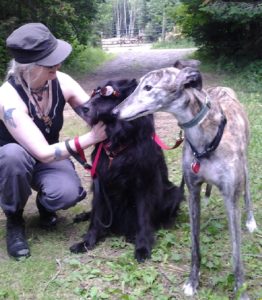 She has had a stressful year, losing Sach was a blow to her, I know. She was stressed as we took care of Gleann’s situation. I feel like we had just gotten to the point where we could all relax and enjoy time together when she got really sick. I don’t want this to have been her last year! I want her to get better, which she has a very good chance of if we start treatment this week, and have a couple of relatively happy years. She just turned 7, she needs more time!
She has had a stressful year, losing Sach was a blow to her, I know. She was stressed as we took care of Gleann’s situation. I feel like we had just gotten to the point where we could all relax and enjoy time together when she got really sick. I don’t want this to have been her last year! I want her to get better, which she has a very good chance of if we start treatment this week, and have a couple of relatively happy years. She just turned 7, she needs more time!
And Gleann needs more time with her. He adores her, he’s lost so many packmates in his lifetime.
Please share the campaign and please help with what ever you can!
My articles and workshop vouchers are available as perks.
The Celtic Hound reference is….because they are!
Saving Ritual Dog Gleann! and some stuff on future workshops
In my last post I asked for help getting Gleann’s high calcium issue diagnosed. We got the diagnosis and it is primary hyperparathyroidism caused by a nodule in one of his parathyroid glands. So now we need to get the surgery as soon as we can! So we have another fundraiser to get his surgery. It was supposed to end this past weekend, we had hoped to be scheduling the surgery yesterday, aiming for the 14th. But we are still far short of the $3,500 we need.
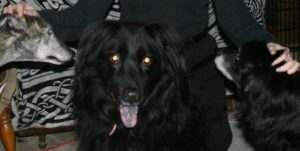 |
| Just before heading out for Samhuinn 2015 |
Gleann is by far our Chief Ritual Dog. I have written about canines in ritual and all our dogs have participated with us. The Greyhounds have been happy to do so, there is food after all, dear little Sachairi I think found it kind of odd as he came to live with us when hew as set in his ways from a probably more Zen background than our wild Heathen ways and he would often lie a little way from us …until the shortbread started being distributed. But Gleann loves ritual!
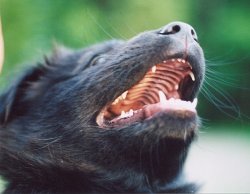 He was just weeks old when he came to live with us, all teeth and growls and unruliness, and a few weeks later we did our Lùnasdal/Là Fhéill Mhacha. Almost as soon as we got there Gleann started running as fast as his little legs could take him deiseal around the fire pit. We would get him to stop, but as soon as let go he’d just start running again. Through the whole ritual. With a break for shortbread.
He was just weeks old when he came to live with us, all teeth and growls and unruliness, and a few weeks later we did our Lùnasdal/Là Fhéill Mhacha. Almost as soon as we got there Gleann started running as fast as his little legs could take him deiseal around the fire pit. We would get him to stop, but as soon as let go he’d just start running again. Through the whole ritual. With a break for shortbread.
By Samhuinn that year he was a bit calmer, and he began to figure out his role. We go up to the site, he patrols the area for any problems. He then hangs nearby, and keeps a look out around. When we make our treaty offerings to those we do not worship, he goes out near the edge of the land with me (he did at first venture to the neighbors but we convinced him that was too much and he no longer does. When the ritual is done and the other dogs and stuff has been packed up and mostly taken home, he and I usually sit alone to vigil with the fire to be sure it is safely out. He had always done this lying right against my back, but as we lost more of the pack and they are buried there he now divides his time lying by their graves and at my back.
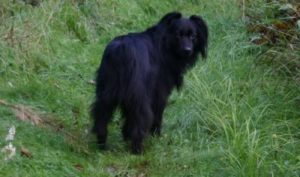
I have written a lot about the importance of canines on my path; the history of dogs in Celtic, especially Gaelic, cultures and a growing body of work on fénnidecht and the connection between warriors and canines. This is also my life. This is my pack. Those who have left their bodies are still in my life.
But I am not ready for Gleann to leave his and he shows no sign of being ready either. With this surgery he will not develop the kidney damage that awaits him without it. He can remain as bouncy as he is now for a few more years…..and many rituals. He is supposed to have surgery later this month. If all goes well he should be able to happily resume his ritual duties by Samhuinn (which is about mid November for us).
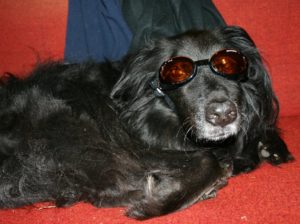 And so, we fundraise and I’m auctioning off some Sarah Connor/Linda Hamilton items with the help of another fan. And we eBay and we apply to funds and we have maxed out CareCredit and we are trying to figure out how to put a business together with no real funds to do so and I have my fitness business on permanent hold due to what it would cost to get insurance again and to get my CEUs in time (which will mean it will cost much more to start all over again if I don’t manage after a very short period after my certification is up).
And so, we fundraise and I’m auctioning off some Sarah Connor/Linda Hamilton items with the help of another fan. And we eBay and we apply to funds and we have maxed out CareCredit and we are trying to figure out how to put a business together with no real funds to do so and I have my fitness business on permanent hold due to what it would cost to get insurance again and to get my CEUs in time (which will mean it will cost much more to start all over again if I don’t manage after a very short period after my certification is up).
And the fénnidecht related workshops planned for this winter are on hold mostly due to my absolute lack of concentration.. The syllabi are only partially finished and I have done none of the more daunting work of figuring out how to present online, given that I live in a geographically isolated area and those interested are so spread out.
However, I intend to have these started by this time next year and therefore am offering vouchers for cost off of future workshops on the fundraiser.
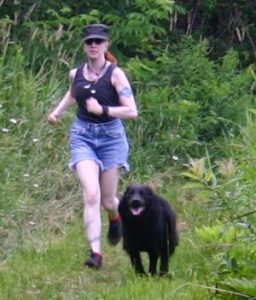 These workshops are, after all, directly related to the sort of connections that my relationship with Gleann and my other dogs represent. I have one that is very basic for those just starting out and that might be of interest to those not on the Outlaw warrior path to help understand where it can fit in modern Gaelic Reconstructionist Paganism and maybe open their own traditions to those on this one. I have varying degrees of exploration for those on the path, including a deeper look at being wolf. I also have a broader look at animals in the cultures that goes beyond the usual symbolic focus most resort to into where practicality, actually living and relying on these animals, led to the symbolism and how it can lead back to real relationships with living animals. And a fitness one (provided I am able to renew my certification in time).
These workshops are, after all, directly related to the sort of connections that my relationship with Gleann and my other dogs represent. I have one that is very basic for those just starting out and that might be of interest to those not on the Outlaw warrior path to help understand where it can fit in modern Gaelic Reconstructionist Paganism and maybe open their own traditions to those on this one. I have varying degrees of exploration for those on the path, including a deeper look at being wolf. I also have a broader look at animals in the cultures that goes beyond the usual symbolic focus most resort to into where practicality, actually living and relying on these animals, led to the symbolism and how it can lead back to real relationships with living animals. And a fitness one (provided I am able to renew my certification in time).
So if you are interested in these worshops, please consider making a donation and taking a voucher! And if you are not but just want to see a beautiful dog have a few more happy years, please just donate. And there are some pieces of jewelry and a bag for perks…and more things may be added.
Excerpt from “The War Goddess’s Bitch”
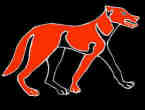 This is from my article in Air n-Aithesc Vol III, Issue 1 currently available in hard-copy or e-copy from this link. Unlike previous excerpts, this in not the beginning of it, as I began with a dream sequence that would be too long for a lead in and I don’t want to post only part of. The article is a continuation of my exploration of the fénnidecht wolf-warrior path, specifically how I follow it as a devotion to the Morrígan and some material on female werewolves, weredogs and dog-heads.
This is from my article in Air n-Aithesc Vol III, Issue 1 currently available in hard-copy or e-copy from this link. Unlike previous excerpts, this in not the beginning of it, as I began with a dream sequence that would be too long for a lead in and I don’t want to post only part of. The article is a continuation of my exploration of the fénnidecht wolf-warrior path, specifically how I follow it as a devotion to the Morrígan and some material on female werewolves, weredogs and dog-heads.
The War Goddess’s Bitch
Wolf-warrior cults are usually attributed to male Gods. The Vedic Indra and Rudra, the Germanic Odin and the Greek Apollo Lykeios have all been associated with wolfish warrior bands.[i] Kershaw states that there are no known Celtic Gods associated with warbands, other than seeing a similarity between Finn and the Fíanna and Rudhra and the Maruts.[ii]Kershaw also mentions McCone’s pairing of Ódinn/Týr and Lug/Núada as teuta/koryos(civilization/warband or wild) God pairings.[iii] Lug is certainly a candidate for such a warrior cults: His relationship to both Cú Chulainn and Finn, adds to this possibility.[iv]While I would not argue against Lug, Finn (as a God, although I tend to focus on his nature as a semi-divine hero) or other Gods as having had such cults, I believe that it is as likely that the Goddesses who fall under the title the Morrígan were also likely to have been the Divine leaders of such cults.
The Morrígan’s interest in Cú Chulainn, the Hound of the Smith, is evident throughout the TBC and related Ulster tales. Some see their relationship as confrontational, often confusing. Epstein has speculated that She may indeed be his patron Deity.[v] Epstein noted that the seemingly adversarial nature of Her relationship with Cú Chulainn can be seen as an effort to strengthen his glory, as I have also explored.[vi] Epstein specifically brought up the similarities between his canine nature, which goes far deeper than just a name, and the Norse ulfheðnar (“wolf coats”) and berserkr (“bear coats”) who followed Odin. She speculated that this might hint at an ecstatic cult dedicated to an Morrígan.[vii]
This ecstatic, shape-shifting nature suggests such a cult as well as the obvious canine connection. Cú Chulainn’s name connects him with canines: he is the Hound, actually acting as Culainn’s guard dog as a boy, to replace the dog he killed.[viii] Yet his form of shape-shifting, his ríastrad (warp spasm), is not decidedly canine. By killing the guard dog and then assuming the dog’s role, Cú Chulainn was transformed completely into a hound not only for his time of service to the Smith but for the rest of his life.[ix]He was always a hound. He was just wilder, more dangerous, rabid, when he transformed and he described himself as having canine fury in Tochmarc Emire.[x]His identity as the Hound was so significant that when St. Patrick conjured Cù Chulainn’s specter in order to convert Lóegaire, the king of Ireland, the specter’s canine nature convinced the king that the specter was truly Cú Chulainn.[xi]
Cú Chulainn’s story gives no indication of him as part of a warband. This lack is likely related to animosity between the church and such warriors they called díberga (marauders, brigands).[xii] It is notable that the ecstatic transformation and the connection to a Deity were revealed at all. When the stories of warbands were finally set down, the Fíanna seem quite divorced from the earlier, negative, accounts of the díberga, that displayed little association with either shape-shifting or Deity.[xiii] The association with hounds is strong in the stories around Finn Mac Cumhail. There are many members of the Fíanna with canine names. However, the fénnidi’s own canine nature is only hinted at vaguely. Finn did have the hood of Crothrainne, which allowed him to turn to hound or stag, yet there is little evidence of him using it.[xiv]In one alternative tale of the birth of Bran, Finn was his father by a woman enchanted into the form of a bitch. One might choose to speculate that he used the hood at that time.[xv]
Read more by purchasing AnA here
[i] Kris Kershaw, The One-eyed God: Odin and the (Indo-) Germanic Männerbünde, Journal of Indo-European Studies, Monograph No. 36., Washington D.C.: Institute for the Study of Man Inc., 2000, such Gods and Their cults are the subject of the entire study, however particular interest might rest in ch. 9 “Odin Analogues” pg. 182-200; Dorcas Brown and David Anthony, “Midwinter Dog Sacrifices at LBA Krasnosamarskoe, Russia And Traces of Initiations for Männerbünde” Paper presented, Conference: Tracing the Indo-European: Origin and migrations. Roots of Europe Research Center, University of Copenhagen, Denmark Dec 11–13, 2012.[ii] Kershaw, The One-eyed God, pg. 186.[iii] Kershaw, The One-eyed God, pg. 195.[iv] C. Lee Vermeers discussed his relationship with Lú Ardáinmór as a lycanthropic God in a blog post http://faoladh.blogspot.com/2013/05/what-i-domy-own-gods-part-one-my-upg-so.html and has also talked about Apollo as a Wind-Wolf God, http://faoladh.blogspot.com/2011/05/gods-and-goddesses-of-werewolves-wind.html[v]Epstein, “War Goddesses,” Ch. 2.[vi]Epstein, “War Goddesses,” Ch. 2; Lambert, “Musings on the Irish War Goddesses;” also further explored in my blog post “The Morrígan and Cú Chulainn part 1: On Saying ‘No.’”[vii]Epstein, “War Goddesses…,” Ch. 3.[viii]TBC Rec 1 pg. 17-19,140-142; TBC:BOL pg. 23-25, 160-163.[ix] McCone, “Aided Cheltchair Maic Uthechair: Hounds, Heroes and Hospitallers in Early Irish Myth and Story.” Ériu 35, 1984 pg. 8-11, I discuss this act as being linked to wolf-warrior initiations in “Going Into Wolf-shape.”[x]Bernhardt-House, Werewolves, Magical Hounds, and Dog-headed Men, pg. 174, 343.[xi]Joseph Falaky Nagy, Conversing with Angels and Ancient: Literary Myths of Medieval Ireland, Ithaca: Cornell University Press, 1997, pg. 274.[xii] Kim McCone, “Werewolves, Cyclopes, Díberga and Fíanna: Juvenile Delinquency in Early Ireland” Cambridge Medieval Celtic Studies, issue 12, 1986, pg. 3-4; Sharpe, “Hiberno-Latin Laicus, Irish Láech and the Devil’s Men,” Ériu 30, 1979, pg. 80-87.[xiii]Kim McCone, “Werewolves, Cyclopes, …”, pg. 3-4; I discuss other links between the díberga and the Fíanna and canine nature further in “Going Into Wolf-shape” as well.[xiv]Kuno Meyer, ed. and trans., “The Finn episode from Gilla in Chomded húa Cormaic’s poem “A Rí richid, réidig dam” Fianaigecht, 1910, Hodges, Figgis & Co., Dublin, Ireland, pg. 51. http://archive.org/details/fianaigechtbeing00meye[xv]As we’ll discuss shortly, Bran and Sceolang are more commonly said to be the children of Finn’s aunt, however, this tale is noted by Bernhardt-House, Werewolves, Magical Hounds, and Dog-headed Men, pg. 196.
Copyright © 2016 Saigh Kym Lambert
Wolf Copyright © 2002 Aaron Miller, based on Newbigging Leslie stone
Moving things around and more re-self-publishing
Some, maybe, have noticed that I have moved the website to http://dunsgathan.net/feannog/ the old folder will forward you there from old links.
At the same time, I have also created a page to house links (this link goes to said page) to PDFs of articles originally published in Air n-Aithesc (this link goes to the magazines page)
At this time the page has “‘By Force in the Battlefield’: Finding the Irish Female Hero” and “Going into Wolf-Shape” up. Will get the other two I have ownership of up in the near future.
(Re) (Self) Publication Announcements
Summer has been busy, mostly not with writing. Mostly with horses. (although both photos are old…guess not much photography is happening this summer either). Also with allergies…. ~:p And some editing has been happening.
Actually my article in the next Air n-Aithesc is an edited piece, some chunks very rewritten, actually. I’ll be posting when the issue is out very soon!
Meanwhile, as it’s been over a year since “By Blood, Bone and Blade: A Tribute to the Morrígan (Nicole Bonivusto, ed, Asheville, NC: Bibliotheca Alexandrina, 2014) came out, I decided it was now time for my essay in it, “Musings on the Irish War Goddesses” to “come home.”
I started “Musings” as a short piece for the web. But, of course, “short” wasn’t possible. So it was going to be a long piece for the web, possibly as a PDF. Then as I was finishing it up, the call for submissions for BBB&B showed up….and I figured I should submit it. Which I did…..and eventually the anthology came out.
I have now replaced the actual shorter piece I later made for the page (which I had started to house this essay) with an intro to link the PDF of
Musings on the Irish War Goddesses

Excerpt from “Going into Wolf-Shape”
This is my last of the excerpts from past issues of Air n-Aithesc that I have to share. I have previously posted excerpts from “Muimme naFiann: Foster-mother of heroes” and ‘“By Force in the Battlefield”: Finding the Irish Female Hero’. The rest of this one can be found in the first issue, Vol 1, Issue 1.
 The next issue should be out at Imbolc, in just a few weeks. I will try to post excerpts in a more timely manner at that point. ~;) Or maybe I’ll even blog something else. ~:p
The next issue should be out at Imbolc, in just a few weeks. I will try to post excerpts in a more timely manner at that point. ~;) Or maybe I’ll even blog something else. ~:p
Going into Wolf-Shape
Humans have lived with dogs for possibly somewhere between 18,800 and 32,100 years, earlier than previously believed.[i]Given highly social nature of both humans and canines and our mutual ability to hunt in groups requiring good communication skills, it seems natural that the relationship would have started when we were hunter-gatherers. Early Neolithic dog burials in Siberia suggest that during this period dogs held an high status not far below humans, beyond their “utilitarian” usefulness.[ii] How natural the relationship is between humans and canines is something most who live with dogs would readily argue, our ability to relate is a given for us. Science has been proving this point, communication and emotional response are strong and similar.[iii]It would be more amazing if humans and wolves—for dogs are wolves who choose to adapt to live in human packs—had not bonded.
There is a great deal of lore and history regarding the importance of dogs among the Gaelic and other Indo-European cultures. Recent genetic testing has revealed that the rose-eared sighthound originated among the Celtic people.[iv] This ancient hound was the ancestor of the modern Greyhound, the Scottish Deerhound, as well as the Galgo Español, which is probably very similar to the ancient hounds. The warrior and the canine are repeatedly linked in Irish lore. One Irish term for wolf, “mac tire” (literally “son of the land”), seems to have first meant a “vagabond warrior” came to primarily mean “wolf.”[v] Many warriors and kings bore “hound” or “wolf” in their names.[vi] The most recognized is Cú Chulainn, who, as a child, took the very role he became named for, “Culainn’s hound,” after killing the smith’s original guard dog in self-defense.[vii] The Fíanna were renowned for their hunting hounds.[viii]
Read the rest by purchasing Air n-Aithesc Vol 1, Issue 1
[i] Elizabeth Pennisi, “Old Dogs Teach a New Lesson About Canine Origins” Science Magazine Vol. 342 no. 6160, November, 15 2013 http://www.sciencemag.org/content/342/6160/785.full
[ii] Robert J. Losey, et al “Burying Dogs in Ancient Cis-Baikal, Siberia: Temporal Trends and Relationships with Human Diet and Subsistence Practices,” PLoS ONE 8(5) 2013 http://www.plosone.org/article/info:doi/10.1371/journal.pone.0063740?
[iii] Gregory Berns, How Dogs Love Us: A Neuroscientist and His Adopted Dog Decode the Canine Brain, New Harvest, 2013
[iv] Heidi G. Parker, Lisa V. Kim, Nathan B. Sutter et al, Genetic Structure of the Purebred Domestic Dog Science, 21 May, 2004: Vol. 304 no. 5674, pg. 1160-1164 https://www.princeton.edu/genomics/kruglyak/publication/PDF/2004_Parker_Genetic.pdf
[v] Kim McCone, “Varia II.” Ériu 36, 1985 pg. pg. 173
[vi] Joseph Falaky Nagy, The Wisdom of the Outlaw: The Boyhood Deeds of Finn in Gaelic Narrative Tradition, Berkeley: University of California Press, 1985, pg. 44, although far more is in this pages notes 19-22 found on 243-245; McCone, “Aided Cheltchair Maic Uthechair pg. 1-30, especially noted on pg. 12-14
[vii]Cecile O’Rahilly, trans., Táin Bó Cúalngefrom Book of Leinster Dublin: Dublin Institute for Advanced Studies, 1967 English http://www.ucc.ie/celt/published/T301035/index.html Irish http://www.ucc.ie/celt/published/G301035/index.html pg. 23-25, 160-163; O’Rahilly, trans. Táin Bó Cúalnge, Recession 1 Dublin: Dublin Institute for Advanced Studies, 1976 English http://www.ucc.ie/celt/published/T301012/index.html Irish http://www.ucc.ie/celt/published/G301012/index.html pg. 17-19,140-142
[viii] J. R. Reinhard and V. E. Hull, “Bran and Sceolang,” Speculum 11, 1936, pg. 42-58, Nagy, The Wisdom of the Outlaw, pg. 44, 95-97
Copyright © 2014 Saigh Kym Lambert

